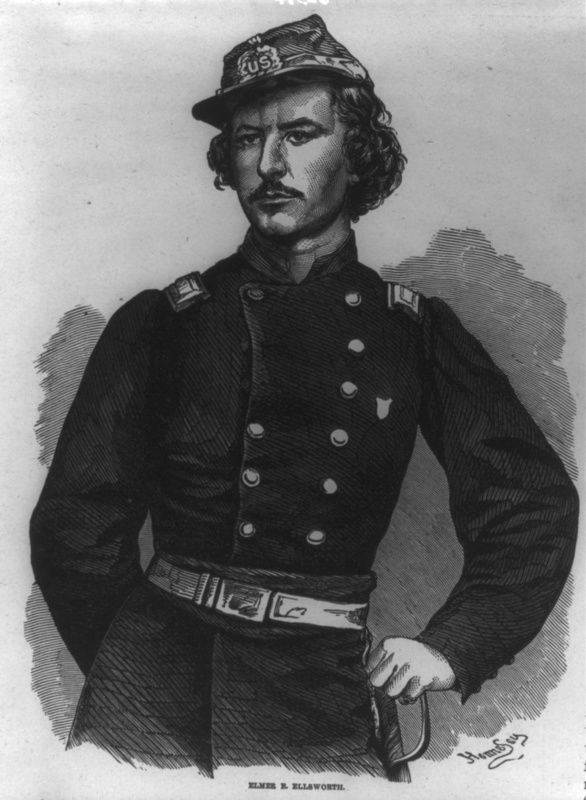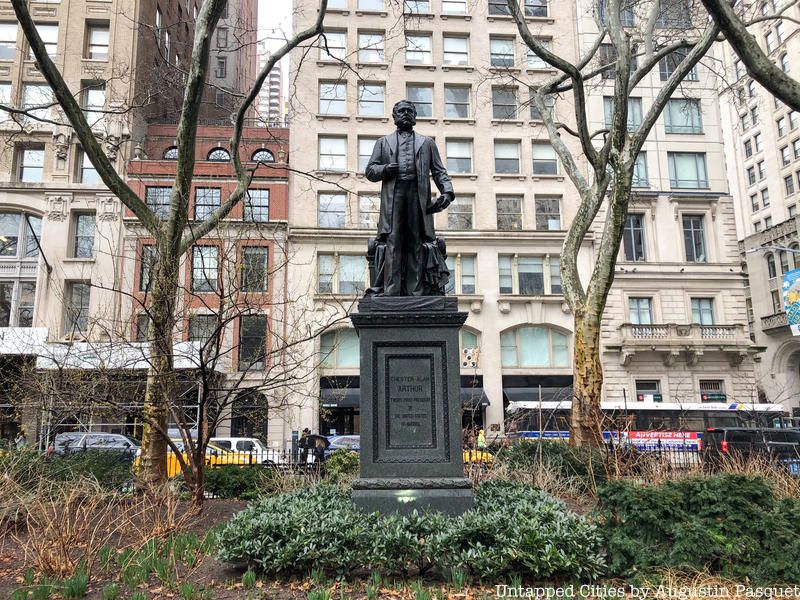Last Chance to Catch NYC's Holiday Notalgia Train
We met the voices of the NYC subway on our nostalgia ride this weekend!


It is estimated that there are about 800 statues in the New York City metro area. While some are of the notable and notorious – of George Washington and Lafayette, Christopher Columbus, Shakespeare, or Lenin, for example – most are about people or events that the average New Yorker or visitor may know very little about. It is even more interesting to note that several of these statues could easily be located in upstate New York where the people or actual historical events the statues are commemorating took place. Let’s take a look at a few of them.

Photo by Don Rittner
In Madison Square Park at Fifth Ave and 23rd Street sits a pretty sizable monument of William Henry Seward (on the SW corner of Broadway and 23rd). Seward was the 12th Governor of New York State from 1839 to 1842.
He was born in Florida, New York, and was a graduate of Union College in Schenectady in 1820. Seward was against slavery (though his father was a slave owner) and won the most votes on the first ballot for President in 1860 though he lost to Abraham Lincoln, who appointed him Secretary of State in 1861. Seward also helped write the Emancipation Proclamation. In the history books however, he is best remembered for “Seward’s Folly,” negotiating the purchase of Alaska.
Seward was also instrumental in getting Europe to not recognize the legitimacy of the Confederacy when it split from the Union and he too had his life attacked by Wilkes co-conspirator Lewis Powell (Paine) but survived. Powell and others were executed for their assassination attempts. Interestingly, a Schenectady Judge, then Major Austin A. Yates, was the “official” executioner.
The Seward statue was created by Randolph Rogers, who was living in New York York City at the time and dedicated on September. 27, 1876. It was conserved in 1995 after more than a century of wear. There was an attempt to erect a statue of Seward on the Union College campus Schenectady but the fundraising came up short. Instead, in 2005, a large 3,700 pound boulder from the Seward Highway in Alaska was placed at the corner of Seward Place and Nott Street with two plaques on it. The school’s campus bus was also renamed “Seward’s Trolley.” His home in Auburn, NY where he grew up is a museum today.

Located 5th Avenue and Washington Place in Washington Square Park, this statue is dedicated to Alexander Lyman Holley, credited in the plaque with being “Foremost Among Those Whose Genius and Energy Established in America and Improved Throughout the World The Manufacture of Bessemer Steel This Memorial is Erected by Engineers of Two Hemispheres.”
Alexander Lyman Holley (1832-1882) brought the Bessemer steel process to America. Holley was from Lakeville, Connecticut, that but the first Bessemer Steel process was conducted in Troy, New York, 150 miles north of the city. Troy was becoming the iron and steel capital of the east during the 19th century and it was here that Holly went into partnership with Troy’s John A. Griswold and John F. Winslow to obtain the Henry Bessemer patent. Griswold and Winslow were already famous at this time, having built and financed the iron plates for the ironclad USS Monitor in 1862, along with John Ericsson. Holley died in Brooklyn.
The Washington Square Park statue of Holley was sculpted by John Quincy Adams Ward, known for his statue of George Washington at Federal Hall and George Washington on his horse in Union Square.

This flagstaff and plaque erected in 1936 located in Christopher Park adjoining Sheridan Square, Christopher, Grove and West 4th Street in Greenwich Village, is dedicated to the first Union officer killed in the Civil War. Colonel Ellsworth, born in 1837 in Malta, north of Troy, grew up in nearby Mechanicville and Troy but moved to Illinois. He drilled his 42 men of the Chicago Zouaes on the morning of July 12, 1860 back in Troy.

Image via Wikimedia Commons, Library of Congress
He became a close friend of President Abraham Lincoln after working for him during the presidential campaign and while studying law. When the war began, he moved to New York City and organized the 1st New York Infantry that became the 11th New York infantry composed of city firemen.
On May 23 1861, Ellsworth and his men were rushing to the rooftop of the Marshall House in Alexandria, Virginia to take down a rebel flag. On the way day, they ran into the owner of the hotel James W. Jackson who killed Ellsworth with a shotgun blast (It was Troy’s Corporal Francis E. Brownell who quickly killed Jackson).
After a burial reception in Washington and New York City, he was brought back to Mechanicville for burial after a large street procession first in Troy. Ironically he was the first victim of the war, with Abraham Lincoln perhaps the last. His death became a rallying cry, “Remember Ellsworth.”

This statue of Alexander Hamilton, in Central Park on East Drive opposite 83rd Street was cast in 1880. Hamilton certainly has a strong New York City connection and died in Greenwich Village, but he also had significant ties to Albany, the capital of New York State.
Hamilton married Elizabeth Schuyler the daughter of Albany’s Philip Schuyer and Catherine Van Rensselaer in the Schuyler Mansion (now a house museum) in Albany on Dec 14, 1790. They had eight children. Coincidentally, his first son Philip also died as a result of a duel in 1801. Hamilton first set foot in Albany in 1777 as a representative of George Washington while visiting General Horatio Gates during the Revolutionary War. He spent the next 24 years visiting Albany to see in laws and tend to his legal and political affairs there.

John Ericsson, a Swedish inventor who became an American citizen in 1848, has two monuments in the city. Ericsson changed the way naval warfare would be battled by designing and building the ironclad U.S.S. Monitor during the Civil War. He wrote a letter to Abraham Lincoln offering to build a ironclad vessel in 90 days. However, Ericsson, a brilliant engineer, inventor of air compressors, boilers, engines, locomotives, naval guns and the screw propeller, was at odds with the Navy after an accident in 1844 in which one of his cannon designs blew up killing the Secretary of the Navy, Secretary of State, and others.
Nonetheless, Ericsson was assisted by two men from Troy, New York, John Griswold and John Winslow. With their help, a letter of introduction was obtained from the Governor of New York and delivered to Lincoln. At a presentation of the Monitor to the Naval Board, Lincoln had the final word. He was holding the model studying its unique features and remarked, “All I have to say is what the girl said when she stuck her foot in the stocking. It strikes me there’s something in it!”
The ship was 172 feet long with a 41 foot 6 inch beam, constructed in parts all over New York State from Albany to Brooklyn. Two 12 inch guns would be housed in a revolving turret. The ship would have a flat deck with only 18 inches of free board and a draft of 10 feet 6 inches. This would allow the ship to easily operate and maneuver in any of the South’s inland waters.
On January 30, 1862, 101 days after the contract was signed, a ship that was unlike anything the world had seen slid down into the East River at the Continental Iron Works. The Monitor had devices containing over 40 original patents on board including a flush toilet. The U.S.S. Monitor steamed for Hampton Roads on March 6, 1862 and on the morning of March 9, 1862 entered the annals of history forever.
Sculpted by Jonathan Scott Hartley, this statue of Ericsson is on the perimeter of Battery Park on State Street across from Bridge Street.

When the first U.S. Census was taken in 1790 most of the residents were Dutch, English, Irish and German descent. Most of the population however were Africans forced into slavery. This number dropped after the slave trade was banned. Then, the Industrial Revolution saw thousands from Europe flocking to America to build factories, railroads, and canals. The Gold Rush of the 1850s drew thousands of Chinese to the West Coast while the Irish seeking refuge from the great famine came east. The rise of technology and steam powered ships made it cheaper and quicker to come to America although the Chinese were banned from entering for 60 years due to the Chinese Exclusion Act of May 6,1882. It was the first significant legislation restricting immigration into this country. President Chester A. Arthur signed the act, which today is a smear for the Capital District since he grew up in Troy, New York where he went to school and taught in the region. He attended Union College in Schenectady. His minster father also preached there and in Schenectady.
Still, Arthur also has a host of liberal activities including support of abolitionist Henry Clay and representing Elizabeth Jennings Graham, a black woman that was denied a seat on a streetcar in Troy in 1854 because she was black. After he won the case, the city’s streetcar lines were officially desegregated..
After just half a year as vice president of the United States in 1881, Arthur found himself President due to the assassination of his predecessor James A. Garfield. Arthur is remembered by historians for his push to reform tariffs, instituting an official navy, and a notable lack of corruption, during an era of corrupt administrations. He died less than a year out of office and was buried alongside his wife and next to his ancestors and family members at Albany Rural Cemetery. His house at 626 First Avenue in Troy sits vacant.
The sculpture of Arthur in Madison Square was sculpted by George Edwin Bissell in 1898.
Next check out 10 Surprising Sculptures You Wouldn’t Expect to see in Manhattan’s Public Spaces.
Subscribe to our newsletter